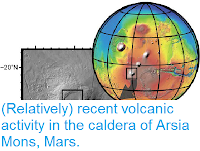The planet Mars will reach apihelion (the furthest point on its orbit
to the Sun) at 11.08 pm GMT on Saturday 7 October 2017, when it will be 1.67 AU (250 000 000 km) from the Sun. This is 0.49 AU (73 000 000) more distant than the planet's periphelion (closest point on its
orbit from the
Sun), as Mars has one of the eccentric circular orbit of any planet in
our Solar
System, this is about half the distance between
the Earth and the Sun, or 33% of Jupiter's average distance
from the Sun.
Because Mars is further from the Sun then the Earth,
it's orbital period (year) is also longer, lasting 1.88 Earth
years. This means that Jupiter will next reach perihelion on 16 September 2018 and aphelion on 31 July 2021. The orbit of Mars makes relatively little difference to the appearance
of the planet from Earth; this does vary considerably over the course of
a year, but is affected far more by the relative positions of the
planets on their orbits (they are currently separated by about 60
degrees) than by the distance of either planet to the Sun. Nor does this
variability have any notable affect on the planet's climate, which, as
with Earth, is influences far more by the tilt of the planet.
See also...
Follow Sciency Thoughts on
Facebook.







